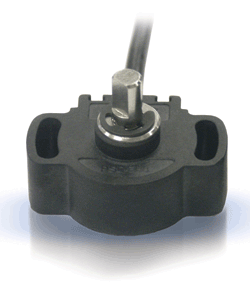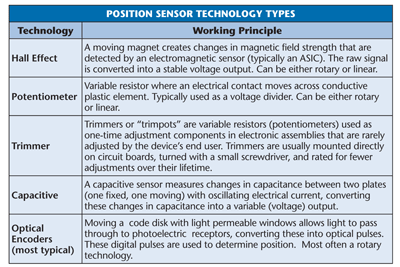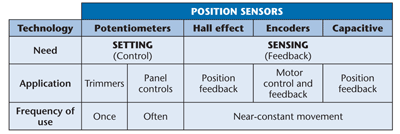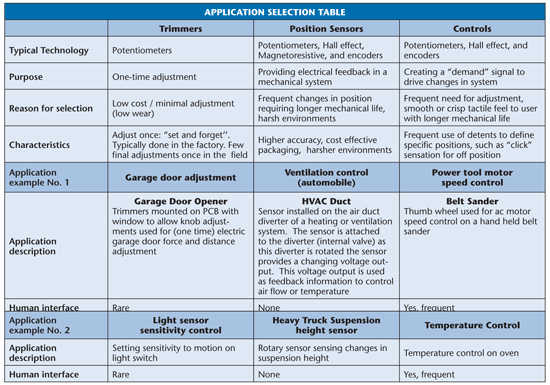Choosing the right term assists with correct component selection
BY PAUL CAIN
Piher International, Libertyville, IL
www.piher.net
The difference between a potentiometer and a position sensor has narrowed over the years and as a result, caused some confusion, especially when trying to determine and select the most suitable component for a given application. What distinguishes a given product so that it ultimately falls into the potentiometer bin or the position sensor bin?

Evolution of pots in design
Historically, the majority of potentiometers were used as trimmers. With the conversion into digital designs, these trimmers were replaced by digital tuning devices that stored their final settings electronically. However, these same digital circuit designs still needed an input to control the system. Potentiometers then evolved and became the preferred low-cost variable-input device. Continual improvements in their durability and performance made potentiometers the most effective solution for input and control.
This recent evolution helps explain why potentiometers, sensors, and controls are commonly interchanged; but to engineers that frequently work with them, there is a substantial difference and the terms are not interchangeable. The potentiometer, or “pot,” is the most mature of the sensor technologies and the one that has migrated into a variety of applications. The common denominators in these applications are position and achieving the most cost effective conversion of position into an electrical output. However, when choosing the most appropriate device, the similarities stop there.
In the past 20 years, designers have substantially increased the number of performance requirements and pots are no longer the single technology solution to these new durability specifications. Pots are only one of many possible sensor technologies. Since their development, pots have been highly successful in position feedback, trimmer, and control applications. The reason they have been so successful is their inherent simplicity. A pot requires only a printed circuit board with resistive ink and a moving contact assembly to generate an output. When used as a trimmer, pots have no real technology drawbacks and they remain the dominant trimmer technology. However, as performance requirements have increased over the years, pots can no longer meet all the common specifications in position sensor and control applications.
Today, there are a number of position-sensing technologies, each with its own strength in meeting the increasing demands for durability, accuracy and long life. Figure 1 provides a brief overview of the working principles used in each of these technologies.

Fig. 1. Brief description of the working principles in common position-sensing technologies.
Finding the proper device
The term “position sensor” is an umbrella term that includes several technologies that all sense position. Potentiometers are only one of many technologies that sense position by converting motion into an electrical output. Hall-effect, optical encoders, and capacitive sensors are all other successful position-sensing technologies. Selection of the most appropriate technology is determined largely on whether the application requires “setting or sensing” (see Fig. 2 ).

Fig. 2. Determining if the application is for “setting or sensing.”
Setting or sensing?
The first step in making this determination is to ask, specifically, will the device be used with frequent adjustment(s) or only as a one-time setting?
If the application requires frequent movements or adjustments, then there are more decisions to make. Does the application involve a human interface that drives frequent changes in an electro-mechanical system? If so, this would constitute a control application and the two most successful control technologies would be potentiometers and contacting encoders.
If the application requires feedback on the position of a moving object, this would be a classic position sensing application where the sensor’s signal is used as an input into a control, servo or feedback system. In these cases, the durability requirements are typically much higher, often requiring thousands or millions of cycles without losing accuracy. The longer the expected life, the more one has to select non-contacting technologies like Hall effect, optical encoders or capacitive solutions.
If the need is a simple, one-time adjustment then a trimmer is ideally suited to meet the requirement. These “set-and-forget” devices are usually buried deep in the assembly and are used for component calibration or factory final testing/tuning. Trimmers have been cost-optimized to provide the highest accuracy, and smallest package size at the lowest possible price. Durability and long life are not a consideration.

Fig. 3. Application selection.
Selecting applications
All of the position-sensing technologies shown in Fig. 3 are successful in their final applications because they achieve the accuracy and durability specification for that one design, at the lowest possible cost.
Selecting the correct technology for each application is driven by the need to “sense” or to “set.” With this decided, then cost, accuracy and durability become the detailed selection criteria. With the Hall effect, encoder and capacitive technologies, you can achieve very long life, at the expense of complexity, component count and cost.
Engineers today are highly specific about their performance needs and with the understanding of each of these technology benefits, we can make more accurate selections with each new design.
So, the next time you hear “just use a pot,” consider all of the alternatives. It’s nice to have so many! ■
Advertisement
Learn more about Piher North America





